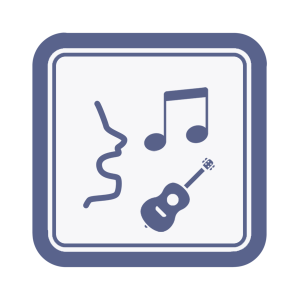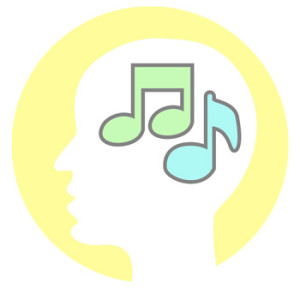
Play and Sing
Learn how to sing and play an instrument at the same time, for example to accompany your singing with chords on a guitar or piano.
After completing this module: you will be able to accompany yourself on an instrument while you sing.
It’s the classic image of a guitar player: guitar in hands, mouth open, singing for the crowd. Whether you play folk acoustic or rock electric, people tend to expect that being a guitar player means you can sing too.
The same can be said for piano (as Billy Joel put it, “Sing us a song, you’re the piano man”) and for many other instruments.
Despite the stereotypes, the majority of musicians actually struggle with singing and playing together.
And it’s no wonder! Singing while playing an instrument can be overwhelming. You’re already having to coordinate left and right hands, remember chord shapes and rhythm patterns, try to keep a steady tempo and play with expression – and now you need to add singing the right notes, staying in tune, controlling your breath and remembering a whole set of lyrics too!
In this module we’ll explore the challenges of adding an instrument to your singing, or vice-versa. Whether you currently just sing, just play an instrument, or do a bit of both but separately, you’ll find helpful tips and strategies to help you learn to sing and play at the same time.
Module Preview
Contents
- Introduction
- Benefits of Playing and Singing
- Getting Started
- How to Play and Sing
- How to Practice
- Extra Tips
- Conclusion
- Try It
The following is an excerpt from “Benefits of Playing and Singing”
Despite all the potential for frustration in starting to play and sing, the benefits far outweigh them.
Even if you intend to stay focused on your instrument, adding singing to your toolkit as a musician will help in a number of ways. Even if you plan to continue as “a singer”, learning to play along as you sing is a smart decision.
Here are a few of the most important benefits of learning to play and sing:
1. You’ll be a better musician.
Simply put, singing is essential for developing your musicianship. There’s no better way to train your ears for music than to use your voice, and you’d be amazed how much more confident and natural you’ll feel as a musician if you start using your voice as the musical tool it can be.
Likewise, if you’re a singer then adding an instrument will broaden your musicality in ways you probably don’t even realise you’re missing out on. You’ll also become a better singer, as accompanying yourself helps you become more aware of the music around you, thereby improving your intonation and ability to perform well with other musicians.
Singing and playing an instrument are each a different world of music-making, and the best musicians benefit from both.
2. It will be easier to communicate with other musicians.
As an instrumentalist you’ve probably experienced those awkward moments and frustrating conversations in band practice when you try to explain “No, it goes DAH dah DUM DAH” and just can’t seem to get your point across. It’s a lot easier to just sing what you mean. You don’t need to be the next X-Factor superstar to do it, and it saves an awful lot of tedious confusion.

By learning to play and sing you come to fully appreciate both the vocal and instrumental parts to a song, and communication in a band becomes much smoother and more enjoyable. You can move much more quickly to a well-integrated and polished performance.
3. You become a more versatile musician.
Being able to sing and play guitar opens up more doors than being a guitarist alone. A pianist who can sing popular songs is far more in-demand than one who can just play arrangements of them.
Whether you’re singing lead, providing backing harmonies in a band, or just getting a group of friends singing at a party, being able to play and sing is a much more useful combination than playing alone. Not to mention it will make you a much more attractive prospect when you next want to join a band.
For singers, learning to play along as you sing allows you to accompany yourself when you practice, which makes it easier to stay in tune than singing a cappella, and is much more flexible than singing along with a recorded backing track. It allows you to perform at open-mic nights, and audition without worrying about finding someone to accompany you and practicing with them beforehand. Simply put, it opens up a lot more opportunities to showcase your voice.
4. You can express yourself more fully and easily in music
 Once you reach an intermediate level with an instrument or singing you begin to enjoy being able to express your own musical ideas. That might be by improvising a solo, playing a song in a different style, or adding emotional expression to your singing performance.
Once you reach an intermediate level with an instrument or singing you begin to enjoy being able to express your own musical ideas. That might be by improvising a solo, playing a song in a different style, or adding emotional expression to your singing performance.
When you can play and sing, your options quickly multiply:
- Want to write songs? Now you can experiment directly with different vocal melodies and accompanying harmonies using your own voice and instrument.
- Want to improvise? Now you can use your voice to practice developing musical ideas before applying it on your instrument.
- Want to collaborate with others to compose, arrange and perform? You can exchange ideas quickly and directly through your voice and your instrument.
5. It’s fun!
This will be hard to convince you of until you make a start, but once you’re past the difficult beginner stage, being able to play and sing really is fun.
There’s something magical about expressing yourself musically with your own voice and instrument that’s hard to understand until you’ve done it.
Instrumentalists: You know that moment of pure flowing bliss as your fingers fly across the fretboard or keyboard in a solo you’ve mastered? It’s a bit like that. Can you imagine getting that satisfaction from your instrument and your voice at the same time?
Singers: Think of the song you most connect with emotionally when you sing it, and then imagine being able to use your hands at the same time, to craft a powerful accompaniment which perfectly matches it.
So how does it work?
Hopefully you’re now convinced that learning to play and sing has a lot to offer you in your musical life.
When you see it done, playing and singing together seems simple. But (as with many things in music) it actually takes hard work and practice to make it seem so effortless!
If you simply try to dive in and do both together, you will most likely find it very challenging. Singing well doesn’t come immediately, and neither does playing an instrument. Even if you can already do both, you shouldn’t expect the combination to be easy.
Fortunately there are ways to make it easy and enjoyable to learn to play and sing.

